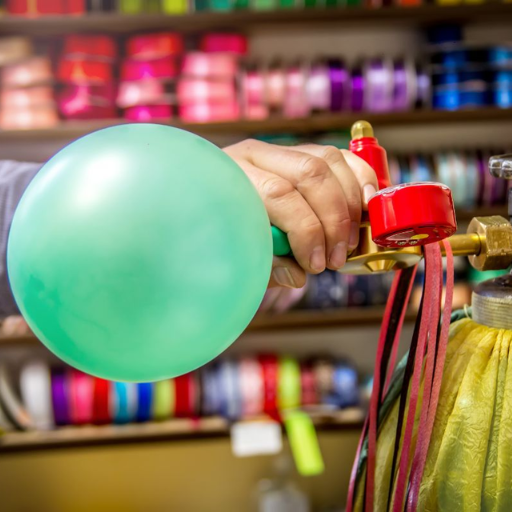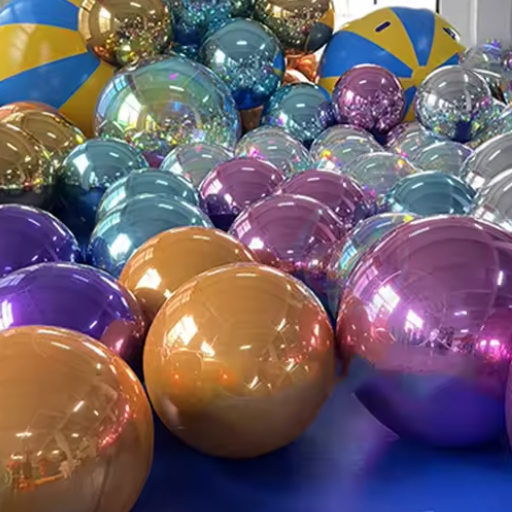Balloons have adorned parties to generate their vivaciousness and cheer in colors, time and time again. The sight of balloons deflated and shriveled way before the time of a party would be devastating. Regardless of the occasion, whether a party, a gathering of women of honor, or a business event, the celebratory aesthetics of ‘balli’ have to be sustained to the very last minute of the event. This article aims to highlight several solutions for preventing air-filled balloons from deflating, thanks to professionals in the field who kindly shared their knowledge. Later in the patch of the content, there will be a study aimed at how to sustain the decorations for the required time and materials for the celebration preparation.
Understanding Why Balloons Deflate

The deflation process of balloons is attributed to the air being lost from within the balloon itself, owing to the tipping over of the balloon walls. Many balloons are manufactured using porous materials like latex, which allows air molecules to pass through over time. The air gets hotter or colder depending on the temperature, which causes it to expand or contract; this, in turn, contributes positively to the faster rate of deflation. Balloons filled with air last longer if they are stored and handled correctly.
How Air Escapes Through Balloon Material
The structure of latex and similar substances contributes significantly to the ability of air to leak from balloons. At the microscopic level, latex has microscopic holes that are not detectable by the human eye, yet are large enough for small gas molecules, such as helium, to pass through over time. This is because helium leaves at a faster rate than air does, as the molecules of helium are smaller and can easily move through these pores. Studies have shown that some helium balloons can deflate by half in 24 hours, with the rate of deflation varying depending on the quality of the material and the surrounding environment.
The current problem is how to prevent air-filled balloons from deflating completely. Most of the time, this problem is rare; however, it can be addressed correctly.
Thermal effects cannot be omitted either. As shown, increases in ambient temperature cause the known inflation mechanism of the material whereby the pores, vis-à-vis, rupture and the gas flows out more rapidly. If, in contrast, the outside temperatures are cold, then the increase in pressure is counteracted by the shrinking of the structures that make up the walls of the container, as well as its pores, thus causing a retardation of the process described above. On the other hand, the main problem with temperature changes is that they compromise the integrity of the balloon, thereby causing its rupture at an earlier stage.
Lastly, the escape of air or gases, such as helium, out of the balloon varies in time depending on the formation of the balloon. An example can be seen with Mylar balloons, which, compared to latex balloons, are non-perforated and therefore hold gases for long periods, unlike latex balloons that release the gas within a few days. No doubt, maintaining such balloons under regulated conditions also enhances their longevity and attractiveness.
Factors Affecting Balloon Deflation
The factors affecting the rate at which a balloon deflates are daily temperature, the material’s nature, and the gas used in its inflation. As follows is a detailed description of these particulars, together with data and research insights:
- Material Properties
The choice of material for a balloon can significantly impact how long it stays inflated. Latex balloons are porous and thus offer little resistance to escaping gas molecules. Mylar balloons are constructed with a thin metallic coating over polyester, which can significantly reduce gas leakage. The data show that helium-filled latex balloons lose 50% of their volume within 8-12 hours, whereas mylar balloons can hold helium for 2-3 weeks or longer, depending on ambient conditions.
- Gas Type
The gas nature used during inflation will affect deflation rates. Helium, being a smaller and lighter molecule than air, escapes through the balloon materials more easily. According to some studies, helium escapes 3 times faster than nitrogen or oxygen over time. Using a gas sealant can slow down the deflation rate of helium balloons.
- Environmental Temperatures
Temperature directly affects balloon performance. Heat expands the gas inside the balloons, increasing pressure that might result in faster leakage. Cold temperatures, on the contrary, contract the gases and temporarily affect buoyancy. A 10% change in pressure is recorded for helium-filled balloons for every 10°F shift in temperature.
- Exposure to Atmospheric Pressure and Wind
Balloons can suffer surface abrasions and develop leaks when exposed to extreme environmental factors, such as strong winds or high atmospheric pressure.
- Humidity Levels
High humidity weakens latex balloons because moisture slowly breaks down the latex material. On the contrary, Mylar balloons tend to withstand humidity conditions better and maintain their integrity for a longer time.
- Proper Handling and Storage
If balloons are kept in a controlled environment, not exposed to either sharp objects, direct sunlight, or temperature fluctuations, their quality fare much better. For example, the float time for helium-filled balloons nearly doubles when kept indoors in a room-temperature setting.
Having understood these considerations, by selecting closely the balloon types, applying sealants, and managing environmental factors, the lifespan and beauty of balloons can certainly be extended.
Temperature and Material Quality
Temperature and material quality are among the decisive factors in determining the lifespan and performance of balloons. The following lists five more key factors of security and their effects:
- Extreme Heat
Heat causes balloons to expand until they break. The extreme temperatures are dreaded for latex balloons since the material has a kind of heat-induced extension, which weakens them.
- Extreme Cold
At low temperatures, balloons shrink and get stiff. Mostly, the result is deflated-looking and wrinkled latex balloons and foil balloons.
- Humidity Levels
High humidity affects the balloon material, making the latex sticky and therefore prone to popping. Conversely, low humidity dries out latex balloons, making them brittle.
- Material Thickness
Rates higher in wall thickness (such as those found in good-quality latex or multi-layered foil materials) can resist temperature fluctuations or any external stress.
- Sunlight Exposure
Sunlight degradation of balloon materials takes place over time. Ultraviolet rays have a degrading effect on latex and foil, causing fading, brittleness, and ultimately breaking the balloons. Various kinds of UV-protective coatings work as a deterrent to this process.
Having a good understanding of the environment helps preserve the balloons under various conditions.
Tips to Prevent Air-Filled Balloons from Deflating

- Pick High-Quality Balloons
Always opt for high-quality latex or foil balloons with a thicker, more durable surface to prevent leaking air. Low-quality balloons are more likely to discolor or puncture quickly, thus reducing their lifespan.
- Inflate Balloons Correctly
Try not to under-inflate or over-inflate any balloons. Balloons can slump when under-inflated, while over-inflation may cause them to pop easily. Use a pump or inflator to inflate to the recommended size by the manufacturer.
- Avoid Excessive Heat or Sunlight
Heat causes temperature expansion inside a balloon, and sunlight just tenderizes and weakens it, resulting in air leakage or bursting. Store the balloons in a shaded and cool area to prolong their longevity.
- Seal Bag tightly and Use High-Quality Ties
Seal valve necks well using proper ties or tape to prevent leakage. Test the tightness of your ties so that no leakage occurs over time.
- Apply Balloon Treatment Solution
Use a balloon sealant solution: For latex balloons, Hi-Float is one such sealant that creates a barrier inside the balloon. Air leakage slows significantly, and the implications for balloon life span can extend to extra days, even weeks.
Choosing High-Quality Latex Balloons
Whatever the occasion or setting for decoration, choosing the right latex balloon is imperative in terms of durability, safety, and appearance. Some factors and data for consideration while choosing high-quality latex balloons are as follows:
- Material and Thickness
Such balloons, colloquially known as gold standard latex balloons, being made from 100% natural latex, offer an environmentally friendly option. The thicker the latex balloon, the more durable it is and the less likely it is to pop. For instance, premium brands typically range from 0.20 to 0.35 mm in thickness, while lower-quality balloons may only measure 0.10 mm.
- Brand and Reputation
Choose reputable names in the balloon industry, such as Qualatex or Tuf-Tex, well-known for their consistent quality and durability. According to customer reviews and feedback, these brands retain air or helium longer and come in a wider variety of bright colors.
- Color Vibrancy and Variety
Quality balloons can be found in nearly every color, especially metallic and pastel finishes. For example, Qualatex offers over 70 color choices, and the dyes used in manufacturing are guaranteed to remain brilliant for hours after inflation.
- Testing for Longevity
Studies suggest that treated latex balloons with protective coatings such as Hi-Float last two to three times longer than untreated ones. Untreated helium-filled balloons typically float for about 8 to 12 hours, whereas treated ones can float for more than 3 days.
- Environmental Impact
Being from the rubber tree, latex balloons are biodegradable and disintegrate when exposed to sunlight and oxygen. Studies have shown that these balloons decompose at a rate comparable to that of an oak leaf, making them an environmentally friendly choice.
The selection of medium-quality latex balloons brings life to the most basic celebrations, with some durable aspects that help lessen the impact on the environment. A much better choice is choosing the most superior brands and inflating the balloons correctly. This way, they remain vibrant throughout the whole event, and their reliability stays intact.
Proper Storage Techniques
Latex balloons require appropriate storage to prolong their life and maintain their quality. Following suitable storage procedures ensures that the balloons remain strong and ready for use when needed. Below are the five storage guidelines:
- Store in a Cool, Dry Place
Latex balloons are very sensitive to temperature and humidity. Holding them in a temperature range from 50°F to 75°F (10°C to 24°C) would stop them from degrading.
- Avoid Direct Sunlight
Excess sunlight would cause the weakening of the latex, rendering it unable to regain its elasticity or even its capacity for discoloration. Store them in a couple of opaque containers, or they will need to be kept in shaded areas.
- Keep Airtight
Place the attractions in a sealed bag or container to prevent them from being affected by oxygen and moisture. This can eliminate half of the aging process for them.
- Away from Sharp Objects
Store balloons away from items with sharp edges or surfaces that could prick or damage them. Additional protection can be afforded by using smooth and padded storage boxes.
- Rotate Stock Regularly
Latex balloons have a life span of 12-24 months. Keep the older stock on top for use and label it with dates to track the inventory and avoid wastage.
By following these procedures, you can keep your balloons pristine until the very next function.
Correct Inflation Methods
When it comes to correct inflation methods, I always ensure I use a hand pump or electric air pump for latex balloons, so as never to overinflate a balloon and risk it bursting. The balloons are gently inflated, stopping immediately upon reaching the recommended size to avoid putting unnecessary stress on the material. Furthermore, when handling compressed gases such as helium, I am careful not to use it recklessly, as it can compromise the health and longevity of the balloons. This cautious attitude ensured that the balloons would always look their best for any event.
Using DIY and Commercial Solutions

Combining DIY options with industrial ones is the most effective way to set up and prepare balloons for an event within a reasonable timeframe and on a budget. DIY means getting out your hand or foot pump and getting on with your business. These methods are pretty affordable and are readily available to the average person. Electric, commercial inflators should be prepared for larger shows to save time and reduce labor when inflating large volumes of balloons.
Recent studies suggest that electric balloon pumps can inflate a standard 12-inch latex balloon in 2-3 seconds, over 10 times faster than the manual method. Additionally, investing in high-quality materials, such as good-quality latex or Mylar balloons, helps reduce the likelihood of popping. Industry sources indicate that when balloons are treated with commercial-grade sealants, their lifespan can be extended by 25%. Helium balloons typically float for 12-20 hours on average, depending on size and material.
DIY approaches that impart their personal touch include double-stuffing balloons to achieve unique colors or designing balloon garlands using everyday tools. On the other hand, professional solutions give large-scale decorations a sleek touch of precision and consistency, utilizing technically pre-designed balloon tying tools and automated sealing technologies. This hybrid approach provides the ideal setup for versatile, professional, and reasonably priced balloon arrangements to fit any event.
Applying Balloon Sealant for Longevity
Based on the valuable opportunities to increase the lifetime and outlook of helium-filled balloons, a balloon sealant acts by providing a protective coating inside the balloons, thereby decreasing helium leakage and maintaining their buoyancy. Here are five interesting facts and data about the use of balloon sealant for longevity:
- Extended Float Time: Balloons treated with sealant will float up to 25 times longer than untreated balloons, making them suitable for long events or displays.
- Application Process: Through the nozzle, the sealant is typically poured, and then it is usually allowed to distribute. Gently massage the balloon once it is fully inflated, so the sealant receives an even coating.
- Compatibility: Balloon sealants work well with latex balloons, but do not work well with foil or Mylar balloons, as they do not require sealing.
- Environmental Factors: Depending on the type, treated balloons may be better able to withstand temperature fluctuations from retaining their shape and longevity under unfavorable weather conditions.
- Economical: While balloon sealants demand a slight initial investment, they save money in the long term by minimizing helium consumption and frequently needing replacement, especially for large or repeated installations.
In this way, event planners and decorators can ensure that balloon arrangements maintain their color and buoyancy for extended periods.
Tips for Patching Small Leaks in Foil Balloons
- Locate the Leak: Inflate the balloon slightly and prepare the mixture of water and liquid soap to locate the leak. Any bubbles that show indicate the pinpoint of puncture and make it easier for us to see.
- Prepare Surface Conditions: After locating the leak, deflate the balloon completely. Clean the area around the puncture with a clean, soft cloth to wipe away any dust, oil, or dirt, ensuring the patch adheres properly.
- Use a Balloon Patching Kit: These specialty balloon patching kits are made with foil balloons in mind and contain adhesive patches. Cut the patch so that it is large enough to cover the leak with some area to spare completely.
- Apply the Patch: Place the patch firmly over the leak, pressing it down for at least 30 seconds to ensure it sticks well to the surface. Give it some time to adhere fully before trying to reinflate the balloon.
- Check if the repair holds: Inflate the balloon slowly and keep it to see if it leaks any air through the hand-made patch. Adjust the placement of the patch or repeat the entire procedure to achieve maximum sealing.
Exploring Hi-Float for Latex Balloons
Hi-Float is specially formulated to enhance the float period of helium-filled latex balloons significantly. The product features a thin coating inside the balloon, slowing the escape of helium through the natural porous surface of the latex. This would be ideal for special events, celebrations, or professional settings where balloons need to remain afloat and visually appealing for several hours.
When used correctly, the Hi-Float can help extend the float time of latex balloons from the usual 8-12 hours to several days, depending on the balloon size and atmospheric conditions. Recent data shows that with the application of Hi-Float, a standard-sized 11-inch latex balloon can remain afloat for three to five days. In contrast, untreated 11-inch balloons lose almost all their buoyancy within a day.
Directions for Using Hi-Float:
- Prepare the Balloon – Stretch out the latex balloon slightly and attach it to the tip of the Hi-Float dispenser pump.
- Application – To apply Hi-Float, first, pour the indicated amount of liquid according to the size of the balloon (manufacturer-recommended amounts are usually listed on each product label).
- Even Spread – By gently massaging the balloon, spread the Hi-Float solution evenly over the inside surface.
- Inflate with Helium – Next, immediately after applying the Hi-Float solution, the balloon must be inflated to its fullest size using a helium tank and tied tightly around the mouth.
One crucial factor to consider is that environmental factors, such as temperature, humidity, and direct sunlight, can affect the performance of Hi-Float. For a longer float time, store and use the balloons in a cool, dry setting!
These properties make Hi-Float a valuable tool in the hands of professional party planners and decorators, making it a common choice for designing long-lasting balloon decorations.
Best Practices for Extending Balloon Longevity

|
Key Point |
Details |
|---|---|
|
Choose Balloon Material |
Use foil balloons; they last longer than latex. |
|
Apply Hi-Float |
Coat latex balloons to extend float time up to 25x. |
|
Inflate Properly |
Avoid overfilling to prevent bursting. |
|
Store Balloons Correctly |
Keep in cool, dry, and ventilated spaces. |
|
Avoid Direct Sunlight |
Heat and UV rays degrade balloons quickly. |
|
Use Larger Balloons |
Larger balloons hold helium longer. |
|
Keep Indoors |
Protect from wind, rain, and temperature changes. |
|
Handle with Care |
Avoid sharp objects and rough handling. |
|
Use Light Colors Outdoors |
Reflect heat better, reducing degradation. |
|
Inflate Close to Event |
Inflate just before the event for maximum freshness. |
Handling and Transporting Balloons Safely
Balloons must be appropriately handled and transported to maintain their longevity and appearance. Here are some detailed tips and best practices based on expert recommendations:
- Protect balloons from extreme temperatures: Do not let balloons endure high temperatures or cold during their transport. Heat causes balloons to expand and may sometimes cause them to burst; conversely, cold temperatures shrink them, making them feel deflated. According to industry standards, the suitable temperature range for storing and transporting balloons is between 68°F (20°C) and 72°F (22°C).
- Use Balloon Transport Bags: The balloon transport bags serve to protect balloons from getting damaged during transit. These bags help prevent tangling and provide a secure enclosure to prevent popping. After all, the bags would prevent blows from sharp objects, dirt, or even the wind.
- Sunlight can be dangerous for balloons. Ultraviolet rays weaken the latex or foil materials, causing premature degradation. Therefore, if balloons are moved outdoors, they must be provided with shade or a cover during transportation.
- Avoid Any Sharp or Pointed Edges: When handling, do not allow balloons to come into contact with sharp objects, such as jewelry and keys, or rough surfaces, which could puncture or tear them. Clean the area of any objects that may cause damage to balloons when putting them in a vehicle.
- Control Pressure of Helium While It Inflates: In the case of a balloon being overinflated, it creates tension on the material, making it easier to pop, particularly during the transportation of the balloon. The balloons should, therefore, be inflated only to the sizes recommended by the balloon manufacturer.
- Secure Balloons Properly: For helium-filled balloons, tie them securely with a sturdy ribbon and anchor them to a weight to prevent them from floating away. When transporting several balloons, they should be grouped and tied to the transport bag for greater stability.
- Beware of Static Electricity: Static causes friction and increases the possibility of balloons bursting. Keep balloons away from fabrics and other materials that generate static charges.
With such precautions taken, the risk of an incident under transit that results in balloon damage is significantly reduced, and the aesthetics of the balloons for any event could be assured. Remember, good care and preparation lead to good results in balloon decoration for any event.
Indoor Storage to Prevent Damage
Proper indoor storage plays a crucial role in preventing balloon deterioration and enhancing their longevity. Recent suggestions indicate that balloons should be stored in a cool, dry place with minimal exposure to sunlight or heat sources that could potentially degrade the latex or foil material over time. The storage temperature is preferably maintained at around 65°F to 72°F (18°C to 22°C) to prevent the balloon from becoming brittle or over-expanding due to temperature changes.
Humidity is another thing being controlled, as moisture can soften balloons, thus heightening the risk of tearing. A good humidity level is about 40%-50%, which helps keep the material elastic. To keep these balloons safe from dust, dirt, and moisture, storing them in airtight containers or sealable bags is always a wise choice.
For event decorating, it is best to keep balloons ready ahead of time, but store them indoors until just before use. This is to minimize exposure to environmental stressors such as wind or sun, which can easily deform or prematurely deflate balloons. Inflated in a controlled indoor environment, a high-quality latex balloon has an average lifespan of 12-24 hours without helium, while foil balloons will stay inflated for days and week,s depending on their size and sealing quality.
Proper indoor storage will keep your balloons fresh and intact, allowing you to set up a gorgeous display for any occasion.
Safe Reuse of Balloons
To reuse balloons safely, one must take care to deflate them gently after use, ensuring they are not contaminated or damaged. Storing them in a superb, dry location can help maintain their quality and prevent it from being compromised, making them ready for any other event.
Common Mistakes to Avoid

When used in an event or decorations, the balloons are prone to certain mishandlings during setup or use. These considerations, if kept in mind, will go a long way toward maintaining their colors and functionality.
- Overinflating Balloons
One widespread error is to inflate a balloon beyond capacity and to have it burst. It is imperative that a latex balloon not be filled beyond its recommended size, which is generally stated on the packaging. An overinflated balloon will not only pop, but it will also lose its shape and aesthetic appeal.
- Exposing Balloons to Extreme Temperatures
A balloon is quite sensitive to changes in temperature, both hot and cold. Rising temperatures and glare adversely affect a latex balloon, causing it to expand until it bursts, whereas cold weather causes it to shrink and lose elasticity. Research proves that in just under one hour of being sent out in direct sunlight, the strength of a balloon can lose about 35 percent.
- Using Low-Quality Materials
Cheap or low-quality balloons usually have thinner latex that can easily be torn or punctured. For enduring effects, consider splurging on premium-grade balloons that are made to last. Helium balloons made from high-quality latex or foil tend to last significantly longer than their less expensive counterparts.
- Improper Tying Techniques
The improper securing of balloons would lead to deflation or premature escape. The knot used to tie the balloon must produce a firm hold. Clamping the balloon would be a great option to seal it without damaging its body.
- Cleaning Before Storage
Neglecting hygiene before storage is a common mistake made with reusable balloons. Any dirt or moisture left behind may act as a detriment, causing the material to mold or lose its elasticity over time. Clean the balloons with a soft cloth dampened with water; let them dry thoroughly before storing in a cool, dry place.
- Using the Wrong Gas for Inflation
The types of gas used may affect the working of balloons. Helium provides the desired buoyancy to balloons but evaporates over time. Latex balloons usually float for about 8-12 hours. The Hi-Float solution will keep them floating for a longer time. Air is also used for balloons; as the name suggests, they do not float with air, but can stay inflated for days or even weeks, depending on the material and sealing.
With these common mistakes removed and considerably more attention paid to detail during installation and use, one can achieve much longer-lasting effects and thus significantly more imposing balloon arrangements for any function.
Overinflation and Its Consequences
Make sure to follow these warnings; overinflated balloons can cause your event to lose its charm as subtle issues begin to arise. Here are five consequences that come with overinflation:
- Bursting
Imagine balloons bursting before the event! Overfilled balloons are prone to pop when exposed to heat, sunlight, or extra pressure from accidental happenings. This causes frequent replacements, which is not an eyesore to the setup.
- Shape Distortion
Balloon overinflation causes them to lose shape and thus diminishes their appeal. Such balloon decorations might not sync well with existing structured designs or themes.
- Shortened Duration of Float
An overinflated helium balloon stretches the latex or foil material too thin. Hence, the escape of helium becomes much faster, thereby shortening float time and duration of longevity and fun at your event.
- Material Weakening
Excessive inflation puts stress on the material of the balloon, weakening it and making it vulnerable to damage from the slightest touch of a sharp object or a rough surface.
- Uneven Appearance in Installations
When overinflated, balloons tend to be inconsistent in size, particularly when placed into clusters or arches, making the arrangement look uneven and unprofessional.
Thus, refraining from overinflation ensures not only the durability of your balloon decorations but also a sleek and consistent look for any event.
Using Balloons in Extreme Weather Conditions
When balloons are expected to face adverse weather conditions, it is essential to consider the effects of temperature, humidity, and other environmental factors on their performance and longevity. Latex balloons are particularly sensitive to temperature changes.
1. Heat and Sunlight
The sun’s heat causes a balloon to expand, and sometimes it may even burst. Latex, being a natural material, loses its quality in direct sunlight and under UV rays. Temperatures above 90°F (32°C) are highly fatal to latex balloons, which become so brittle in just an hour. For instance, controlled tests revealed that balloons exposed to midday sunlight on a 95°F (35°C) day lasted only 2-3 hours before either popping or deflating.
2. Cold Weather
Cold temperatures cause balloons to shrink and lose buoyancy. Under cold conditions, helium contracts, causing helium-filled balloons to appear somewhat deflated if exposed to temperatures below 50°F (10°C). However, once brought back into a warmer setting, the helium expands, allowing the balloon to attain optimum shape. Event organizers using helium balloons often opt for storage at room temperature before actual outdoor use to negate the natural fluctuation in size.
3. Wind and Rain
Strong winds can make it hard to secure balloons, putting them at risk of blowing away or being damaged by rough surfaces. Rain additionally weighs on the surface of balloons, especially foil ones, which in turn lead to tangling or tearing of balloon garlands or arches. It is advised that balloon decor be fastened with stronger ties or weighted bases under such conditions.
4. Humidity
Under high humidity, latex balloons oxidize more quickly, resulting in a cloudy and dull appearance. Greater aggression against any latex balloon in 90% humidity brings visible oxidation within 15 minutes. Alternatively, you can use a balloon shine spray or purchase balloons that have been treated with a protective coating.
Take these precautions to increase any balloon’s life and aesthetic value during extreme weather:
- Do not inflate balloons to their fullest capacity, but rather to approximately 90% of total capacity, to allow for expansion.
- Use heavier weights and quality adhesives to anchor balloons in windy conditions.
- Store balloons indoors at a controlled temperature before usage.
- Use foil or specially designed weather-resistant balloons.
Consider a cinematic approach if you want the balloon decorations to withstand weather extremes, thus remaining valid, elegant, and functional in any environment.
Poor Storage Practices to Avoid
Improper storage of balloons significantly diminishes their quality and lifespan, thereby providing a subpar experience at events. There are five most common bad practices; they should never be adhered to, along with explanations and facts illustrating the consequences upon the balloon:
- Sunlight
When balloons are kept in direct sunlight, they get damaged rapidly due to UV radiation. According to research, latex balloons, when exposed to sunlight, begin to lose their elasticity and strength within a few hours, ultimately bursting prematurely.
- High Humidity
Balloons in a high-humidity climate absorb moisture from the surface, resulting in the sticking of one to another or the development of weak masses. Aim for a Humidity lower than 50% in storage.
- Inconsistency in Temperature
The repeated variation of temperature causes the weakening of the balloon material. For example, latex balloons become brittle in cold weather and overstretch in hot weather.
- Close to Sharp Objects or Rough Surfaces
An unfortunate risk lies in placing balloons near sharp edges or rough surfaces, as opposed to storing them in smooth containers that can preserve their integrity.
- Overcrowding
Filling storage places allows balloons to be pressed or distorted, altering their shape and negatively impacting their appearance when inflated. Ensure there is sufficient room to store balloons without undue pressure being placed upon them.
By avoiding these common storage blunders, you can significantly increase the durability and reliability of your balloons, ensuring they remain in excellent condition for essential events.
References
-
MIT DSpace: Design of a large-dose minimally invasive drug delivery device for Tuberculosis – Discusses air-filled balloon mechanisms and their maintenance.
-
Springer: Air-filled vs water-filled intragastric balloon: a prospective randomized study – Explores the behavior and durability of air-filled balloons in controlled environments.
-
PubMed Central (PMC): Optimal filling solution for silicone Foley catheter balloons – Provides insights into air-filled balloon deflation and maintenance.
Frequently Asked Questions (FAQ)
How to keep your balloons from deflating?
To keep your balloons from deflating, consider using high-quality balloons, avoiding direct sunlight, and storing them in a cool, dry place. You can also use products like Hi-Float to create a barrier that helps prevent air from escaping.
How long do helium balloons last?
Helium-filled balloons typically last 8 to 12 hours, depending on the type of balloon and environmental conditions. Using a sealant can help extend the lifespan of your helium balloons.
Do latex balloons last longer than foil balloons?
Foil balloons, also known as Mylar balloons, typically last longer than latex balloons because they are less porous. Latex balloons tend to deflate faster because the air inside escapes more easily.
How to Store Your Balloons for Longevity?
To ensure your balloons last longer, store them in a cool, dry place away from direct sunlight and hot air. Keeping your balloons in a sealed plastic bag can also help maintain their inflated state.
What can I do to keep my helium-filled balloons afloat longer?
To keep helium-filled balloons afloat longer, you can use Hi-Float, a liquid that coats the inside of the balloon and slows down the helium from escaping. Additionally, avoid exposing them to heat and direct sunlight.
How long do latex balloons last when inflated?
Inflated latex balloons typically last 5 to 7 hours, but their lifespan can be extended by keeping them in a calm environment and out of direct sunlight.
What happens if I deflate the balloon?
If you deflate the balloon, it will lose its shape and buoyancy, making it unable to float. Once a balloon is deflated, it cannot be reinflated to its original state.
How can I keep my balloons away from the heat?
To keep your balloons away from heat, avoid placing them near windows, heaters, or any area exposed to direct sunlight. Storing them in a shaded, cool area will help maintain their inflated state.
Do larger balloons last longer than smaller ones?
Larger balloons can sometimes last longer, as they have a greater volume of air or helium inside, which helps them stay inflated for a longer period. However, material quality and environmental conditions also play significant roles.









